Submitted by WA Contents
Global Leaders and Architects discussed Megacities and Dense Vertical Urbanism at CTBUH 2016
China Architecture News - Nov 05, 2016 - 11:34 24212 views

CTBUH 2016 International Conference was held between October 16-21, 2016 in Shenzhen, Guangzhau and Hong Kong with participation of many global leaders, architects, urbanists and developers, hosting over 1,350 delegates from 46 countries. This year's theme was 'Cities to Megacities: Shaping Dense Vertical Urbanism', Timothy Johnson from NBBJ, Yansong Ma from MAD Architects, Winy Maas, MVRDV, Yan Meng from Urbanus, Patrik Schumacher, Director of Zaha Hadid Architects and Jerry Yin from SOHO China were only a few of the speakers who discuss on Tall Buildings and Dense Vague Urbanism.
Hosted by the Council on Tall Buildings and Urban Habitat, the 'CTBUH 2016 International Conference' plays an important role to delve into speculative urbanism in cities shaped through migration, inconsistent planning policies, client decisions, climate change and insufficient infrastructure and the conference investigates all negative and positive major and key aspects of healthy/unhealthy and liveable urbanism affecting people's quality of life.
The CTBUH 2016 explores the real impact – both positive and negative – of density, vertical growth, and concentrated urban infrastructure, not only in China, but around the world, this conference educates attendees about the very latest in best practice developments in both skyscraper and urban design from around the world.
The most important point is in the conference that the widescale event embraces numerous tall buildings and urban spaces in the region that have become iconic in their own right, through off-site programs and social networking events. Activities in the conference included presentations by project team members and tours of completed and under-construction buildings, as well as of the greater urban contexts for these buildings.
In an unprecedented first for a CTBUH conference, the event took place progressively across three cities: Shenzhen, Guangzhou and Hong Kong. A portion of the Hong Kong program was held at the world’s highest hotel in the city’s tallest building, the Ritz Carlton Hong Kong at the International Commerce Centre.
We created a short coverage about this global event day by day explaining what were the major discussions about our cities, and read what global leaders and prominent architects said about Tall Building and Dense Vertical Urbanism:
Day 1, Shenzhen

Opening Plenary Sets the Scene for the Five Days Ahead
After some brief words of welcome, the Opening Plenary dove right into the conference theme, charting the meteoric rise from City to Megacity of the Pearl River Delta region while examining innovative concepts of sustainability and density within this urban context.
Long Xiu, Chairman, Architectural Society of China, began the day with a discussion of China’s changing architecture guidelines. Focusing on sustainable design imperatives, Xiu charted the history of China’s architectural evolution and noted the ways in which new guidelines will transform the country’s megacities through innovative design.

Mun Summ Wong, Founding Director, WOHA Architects
Mun Summ Wong, Founding Director, WOHA Architects, shared his vision for the “Garden City, Megacity,” building off of his work with green, socially and environmentally sustainable design to advance a master planning concept for the age of global warming.
This vision involves myriad connected, vegetated high-rise constructs that comprise an elevated urban network. This radical rethinking of what a city could become was the first of many innovative urban development models to be discussed throughout the conference.

Tim Blackburn, General Manager, Development & Valuations, Swire Properties
Day One Presentations Examine the State of Affairs of Megacities. With three sessions of 11 simultaneous tracks, Day One programming was jam-packed with presentations and discussions on a variety of topics related to the conference theme. Naturally, the theory and concepts behind existing and future megacities played a central role in many of the day’s presentations. The wide range of speakers allowed the megacity concept to be examined from multiple angles, with perspectives ranging from design, urban planning, and technology integration to economic considerations and sustainable imperatives, among other themes.
A number of presentations looked directly at the role that tall buildings play in facilitating the urban habitat of megacities, with a particular focus on the concept of polycentricism, or the idea that megacities should embrace multiple tall building nodes rather than the traditional central business district of 20th century urbanism.
This concept was clearly elucidated by Tim Blackburn, General Manager, Development & Valuations, Swire Properties, who argued for a shift from “central” to “core” business districts, saying: “From a planning and practical perspective, it increasingly makes sense to concentrate and cluster multi-story commercial office buildings near to each other to facilitate human interaction, information exchange, and commerce.”

Keith Griffiths, Chairman, Aedas
Transportation connectivity was another overarching discussion of contemporary megacities, with all agreeing that transit-oriented development is an essential design strategy for successfully developing dense urban environments. Keith Griffiths, Chairman, Aedas, argued in his “City Hubs” presentation that transportation nodes will facilitate the creation of ultra high-density, connected, urban environments.
Similarly, Paul Whalen, Partner, Robert A.M. Stern Architects supplemented this vision for connectivity with additional stress on pedestrian oriented developments made possible by ample transport connectivity in his presentation “The Continuous City.”

James von Klemperer, President, KPF
Technological Innovations Inform Discussion on Future Cities. A number of presentations focused on technologies and trends that are set to shape the future of both cities and individual skyscrapers. James von Klemperer, President, KPF, offered an insightful presentation on the concept of “X-information modeling,” a data-driven design process that iterates many hundreds of design options across wide ranging criteria.
“We thought, if we could take the criteria which matter to us the most – sunlight, density, block size, tower location, both factors of design, and resultants of design – we would then find a way to manipulate a tower within a multiple-block zone and find different ways to score these attributes,” von Klemperer said.
Similarly, Patrik Schumacher, Principal, Zaha Hadid Architects, laid out his vision for the future of parametric design, and a Pecha Kucha panel discussion examined the future of our cities directly by asking the question “What are the biggest threats and opportunities of future cities?”

CTBUH Trustee Steve Watts, Partner, Alinea Consulting & Jianping Gu, General Manager, Shanghai Tower C&D
The multi-disciplinary panel had much to say on the subject, with CTBUH Trustee Steve Watts, Partner, Alinea Consulting, declaring, “Cities make up only 2 percent of the world’s surface area but they use up 75 percent of its resources.
That is only going to get worse as the population gets bigger and people continue to flock to urban areas. We send greenhouse gases to the sky, we send plastics and other solid waste to landfill sites, and we send sewage to the ocean. If the World Bank is correct all of that will increase by 70 percent within 10 years – a frightening statistic.”
Day 2, Shenzhen
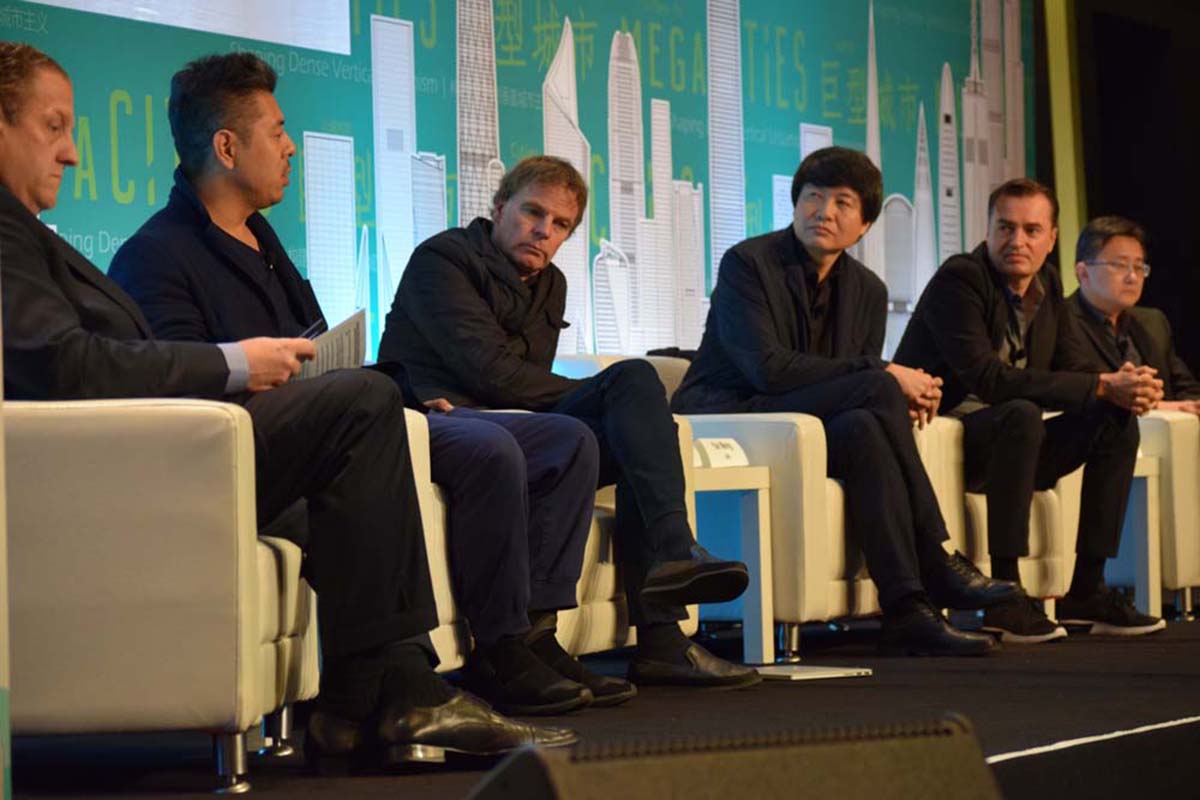
Plenary Panel members left to right: Timothy Johnson, NBBJ (Chair); Yansong Ma, MAD Architects; Winy Maas, MVRDV; Yan Meng, Urbanus; Patrik Schumacher, Zaha Hadid Architects; Jerry Yin, SOHO China Co. Ltd.
Day 2 started with Plenary Panel Discussions Engaging with Vernacular Design. An insightful plenary panel discussion entitled “Tall Buildings and Context: Appropriate High-Rise Vernaculars,” chaired by CTBUH Vice-Chairman Timothy Johnson, Design Partner, NBBJ and featuring a panel composed of Yansong Ma, Founder & Principal Partner, MAD Architects; Winy Maas, Co-Founding Director, MVRDV; Yan Meng, Principal & Co-Founder, Urbanus; Patrik Schumacher, Principal, Zaha Hadid Architects; and Jerry Yin, Senior Vice President / Chief Architect, SOHO China. The session revolved around how to contextualize tall buildings, with each of these high-profile architects and developers bringing unique perspectives to the table.

Patrik Schumacher, Principal, Zaha Hadid Architects.
Patrik Schumacher described the current architectural challenges for the country aptly, saying, “If you keep piling up landmarks, they all cancel each other out and generate a strange homogeneity, which makes every city look the same even though they try so hard to be different.
That’s what we need to overcome.”Echoing this point, Yan Meng added, “A lot of times we see high-rise buildings as foreground figures, and we rely on them to define urban characteristics. We put too much burden on the high-rise…Every single high-rise tries to make a statement and in the end, it doesn’t help the individual building and it doesn’t help the city as a whole.”

Session 6C: Economic Considerations, from left to right: Eric Lee, JLL; Stephen Y.F. Lai, Rider Levett Bucknall; Jason Barr, Rutgers University; Brian Ringley, Woods Bagot
Economics Played a Key Role in Day Two Programs. A number of Day Two programs investigated the economics of skyscrapers. In particular, the Economic Considerations program delved into three distinct but interrelated economic issues. Stephen Lai, Managing Director, Rider Levett Bucknall, presented on innovations in effective cost management for supertall towers; Brian Ringley, Design Technology Platform Specialist, Woods Bagot, discussed the economic efficiencies related to the built geometries of iconic tall buildings; and Jason Barr, Associate Professor, Rutgers University, introduced a compelling economic analysis of skyscraper development in China, which was undertaken as part of the CTBUH 2015 Research Seed Funding initiative.
Each presentation challenged traditional notions of skyscraper economics while offering compelling new analyses on the subject. In particular, Jason Barr summed up his research findings, saying, “If you look at the relationship between skyscraper construction patterns across cities in China and look at their urban populations and their ‘gross city product,’ they are very strong predictors of height and frequency. I would argue that they are perhaps the key motivator. Underlying China’s rapid building is its rapid urbanization.”
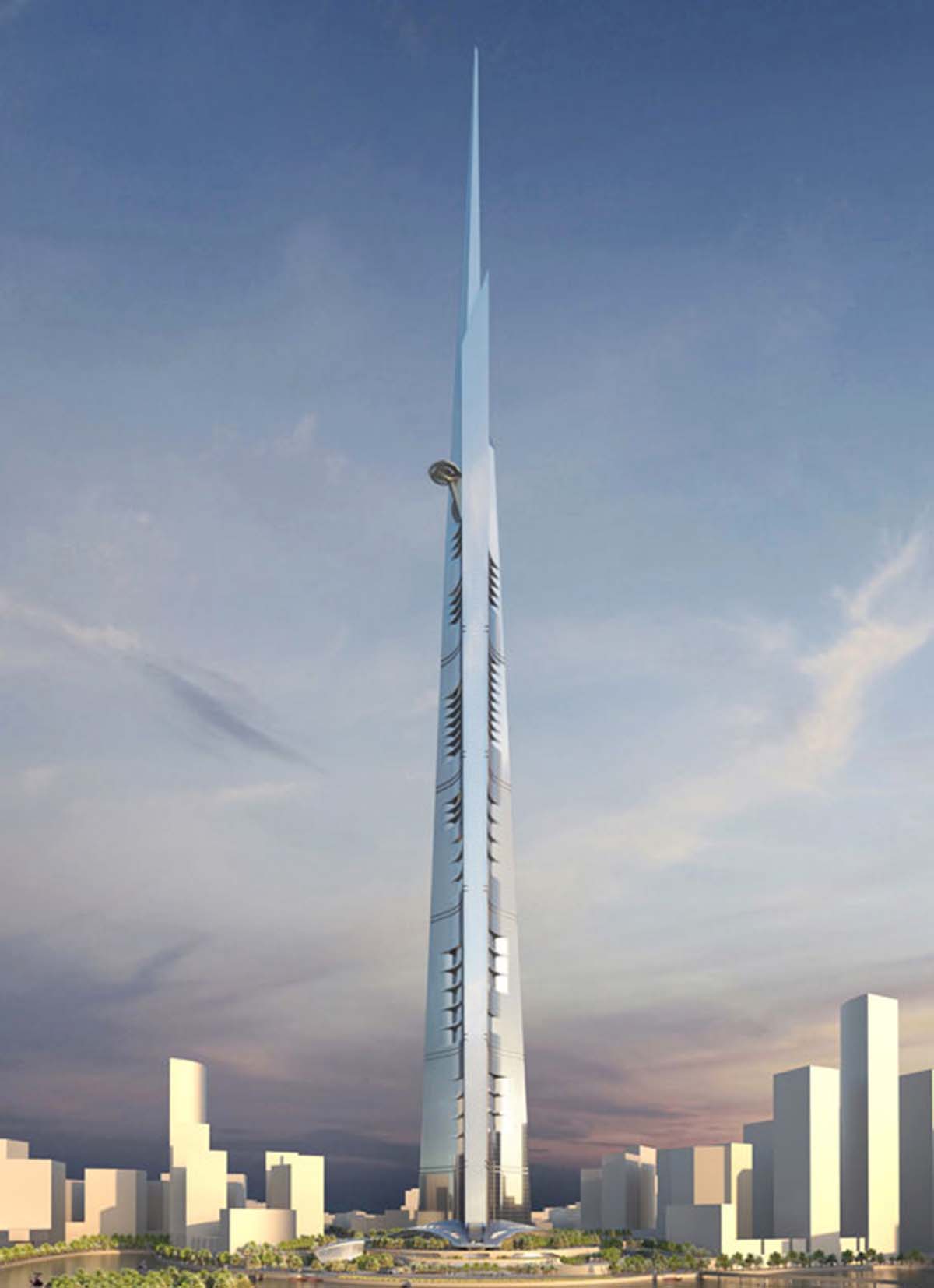
Jeddah City/Tower by Adrian Smith + Gordon Gill Architecture
Day Two Sessions Touched on Urban Habitat in the Megacity. Another theme that shone through on Day Two was, naturally, the urban habitat of our contemporary cities. A number of sessions delved into specific developments, such as Jeddah City/Tower and One Shenzhen Bay, with the intent of deciphering how tall buildings can anchor and catalyze entire urban areas.
Meanwhile, sessions on the public realm and urban environmental issues took a broader approach to the question of modern urban habitats. Discussions here ranged from human scale neighborhoods and public spaces to tower-ground-plane interactions.

Student Competition Winners Lisa Marie Martinez, University of Arizona, and Gonzalo Casado, Universidad Portifica de Salamnca, accept the prize sponsored by KPF
CTBUH Academic and Research Initiatives Put in Spotlight. A number of CTBUH academic and research initiatives were recognized during the first two days of the conference, with several competition winners announced and funding bestowed to research undertakings that will take place over the following year. The CTBUH Student Design Competition was judged during Day One of the conference, with presentations by finalists during Session 3G.
After presentations from the five finalists, the student competition jury, helmed by Robert Whitlock, Principal, Kohn Pedersen Fox Associates, deliberated on a winner. Lisa Marie Martinez, University of Arizona, and Gonzalo Casado, Universidad Portifica de Salamnca, were chosen by the Jury for their project entitled Hydro-City MXDF. They were given $20,000 in funding from competition sponsor KPF.
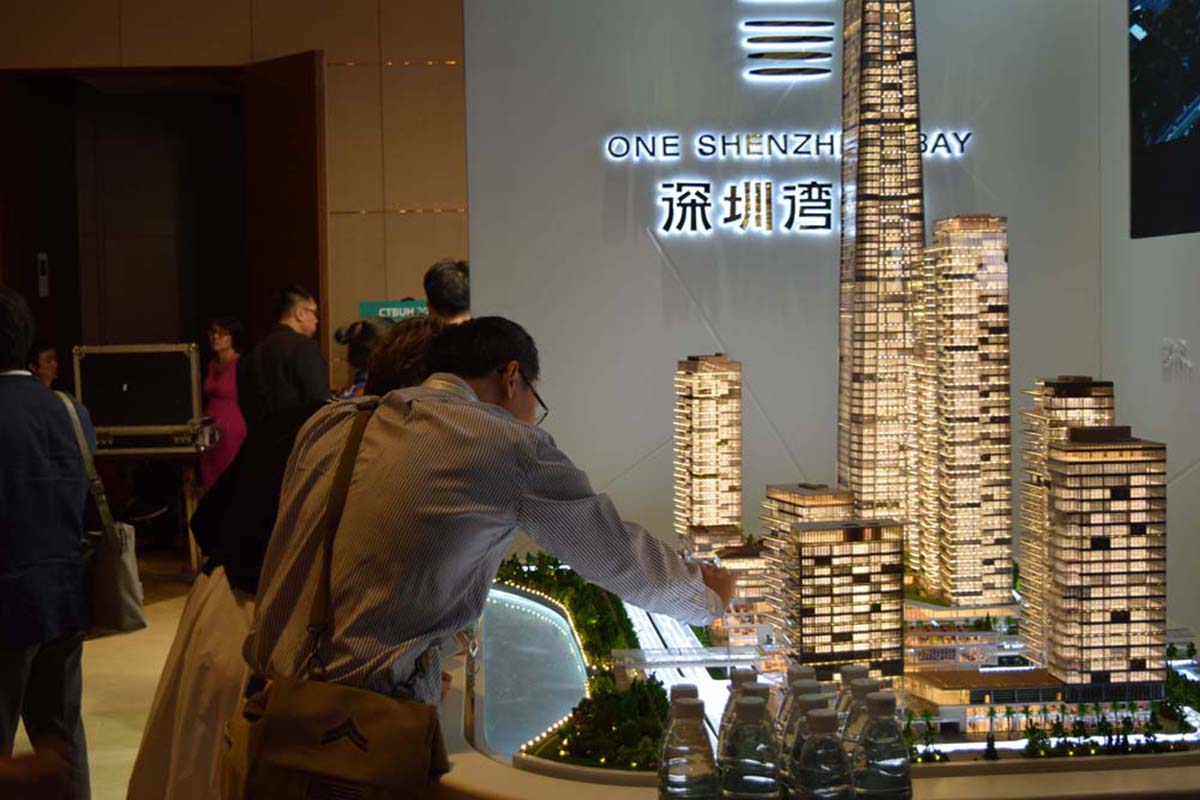
Exhibition Booths Provided Additional Learning and Networking Opportunities. Throughout the day, delegates had the opportunity to visit 29 exhibition booths displayed around the conference venue. Featuring models, displays, printed materials, and other offerings from various conference sponsors, the booths provided additional learning and networking opportunities for all in attendance.
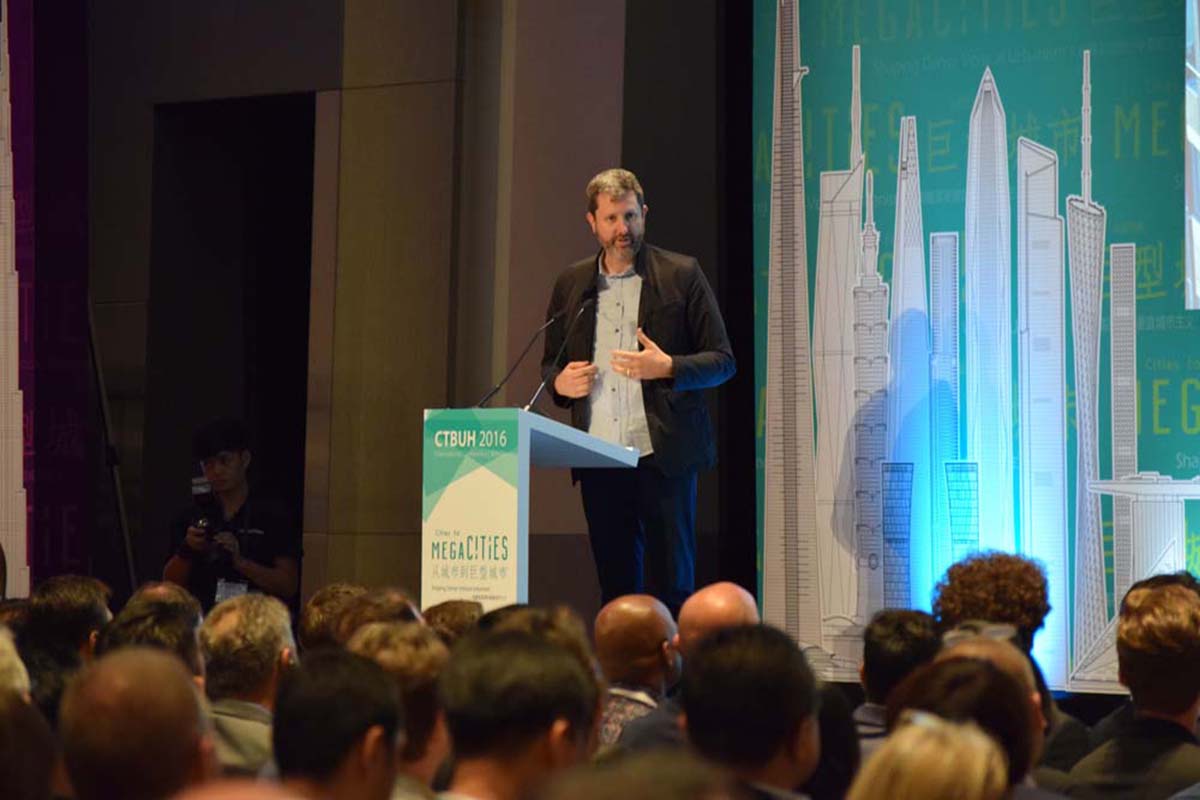
Jonathan Ward, NBBJ
Plenary Speakers Shared Their Visions for our Future Cities. With another busy day of presentations and panel discussions in the rear-view mirror, conference delegates reconvened for the final plenary session of the day, “Cities to Megacities: The Future,” which sought to generate a larger discussion of our contemporary cities’ transformation in the face of growing urbanization.
Three detailed presentations examined the future of the megacity from various perspectives, starting with an investigation by Ivan Wan, Executive Manager, Tencent Holdings, and Jonathan Ward, Design Partner, NBBJ, into the way that tech companies are transforming the traditional high-rise office space through the introduction of advanced technical integration and suburban-office campus-style communal spaces in a high-rise setting.

Winy Maas, MVRDV
Winy Maas, Director, MVRDV, laid out his own vision for future cities with a focus on improving the livability of skyscrapers through vertical urban design. Maas presented a number of conceptual exercises that seek to reframe the human experience in a tall building setting, all presented as they pertain to context, the environment, and a vibrant social sphere.
Day 3, Guangzhou/Shenzhen

Guangzhou International Finance Center
Core Conference Program Traveled to Guangzhou. On the night of Tuesday October 18, following the conclusion of the second day of programming in Shenzhen, many conference delegates boarded buses to make the roughly two-hour trip to Guangzhou. Travelling from Shenzhen through Dongguan and onto Guangzhou at dusk, attendees took in the evening scenery of the greater Pearl River Delta area from the comfort of the open roads.
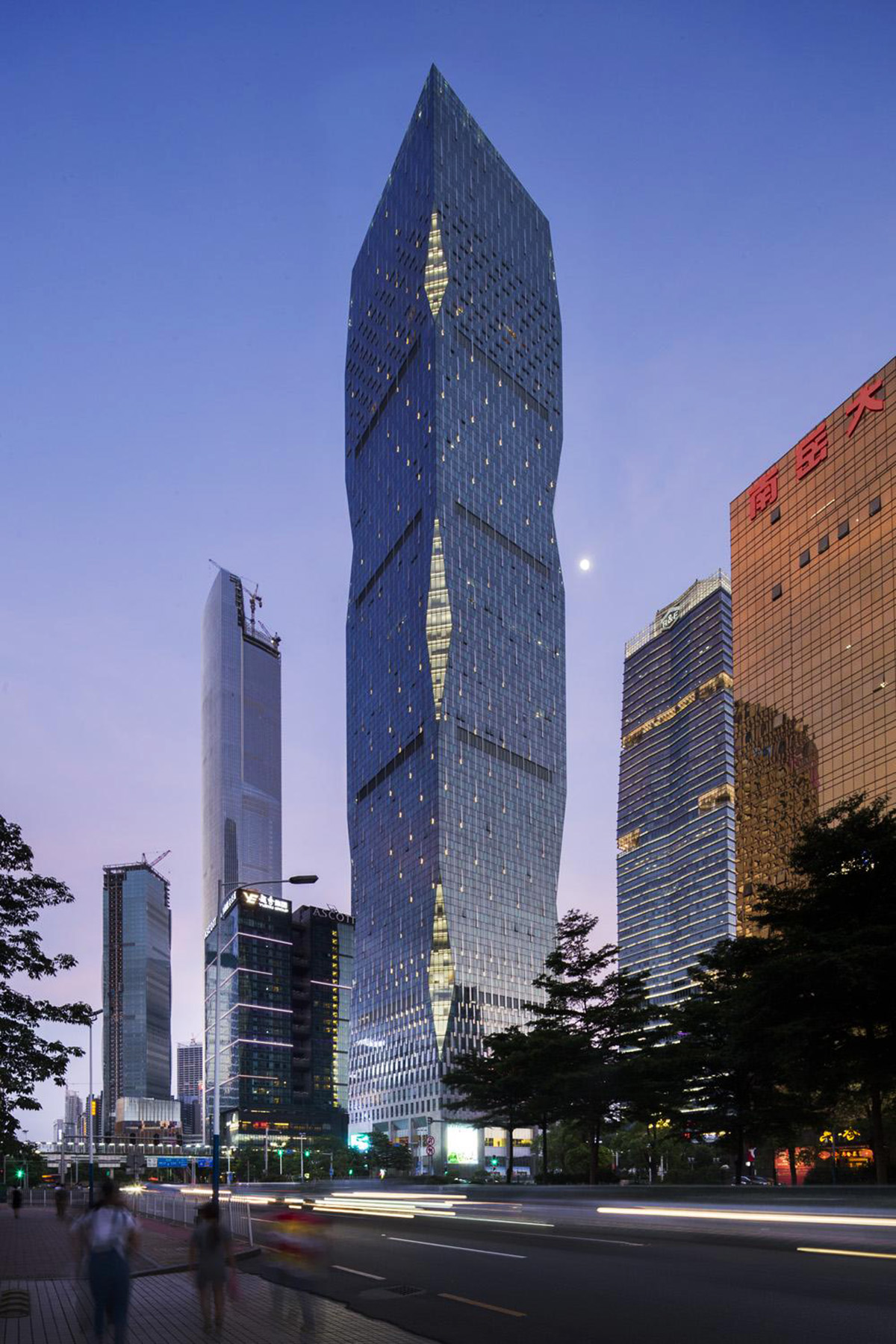
R&F Yingkai Square. Image by SkyriseCities
Morning Off-Site Programs Highlighted Guangzhou’s Urban Habitat. For those in Guangzhou, the morning of Day Three consisted of several off-site programs. The majority of the programs were held within walking distance of the city’s central business district, including R&F Yingkai Square, which hosted a session titled “Zhujiang New Town – Guangzhou’s New Central Business District.”
As the name suggests, this session examined the growing business district that is organized around Huacheng Square. Attendees learned about the history of the area’s development, including the importance of the square as a green “lung” at the center of the city. They were further briefed on the development of R&F Yingkai Square before being given a tour of the recently completed skyscraper.

KPF Director Florence Chan
Day Three Plenaries Investigated Development Patterns in Guangzhou and Around the Globe. In the afternoon, all Guanghzou attendees travelled together across Huacheng Square to Guangzhou CTF Finance Centre, the tallest skyscraper in the city, for the remaining afternoon programming, which consisted of six presentations across two plenary sessions. The first batch of presentations focused on developments in Guangzhou, with specific focus on Guangzhou CTF, Guangzhou Linhe Office, and Pearl River New Town.
KPF Director Florence Chan spoke eloquently about the design and construction of Guangzhou CTF, describing the rationale behind the building’s setbacks and programmatic mix as well as its transport connectivity. When asked about the future of development in China, and what it would take for China to begin undertaking major projects without foreign expertise, Chan offered key insights regarding the need to elevate the importance of execution to the same level as design quality.
Chan stated, “It’s something that the Chinese construction industry [and architects] need to catch up on. It’s the attention that you not only just pay to the quality of the renderings, it goes down to the very last detail of the building – because I see a lot of example which were great ideas on paper, but when it comes down to execution it becomes a little bit of a disappointment.”

Jon K. Galsworthy, RWDI, presenting at Ping An Finance Center
Shenzhen Off-Site Programs Provided Local Context to Day One and Two Programming. While the core conference program moved on to Guangzhou for Day Three, a sizeable contingent of delegates remained in Shenzhen for a day of off-site programming. In total, eight unique programs were offered over two sessions at high-profile skyscraper developments throughout the city.

In the morning, delegates had the opportunity to travel to the recently completed Ping An Finance Center for a session focused on engineering the world’s tallest towers, an apt theme for programming in Shenzhen’s tallest building (and one of the 10 tallest in the world).
Day 4, Hong Kong
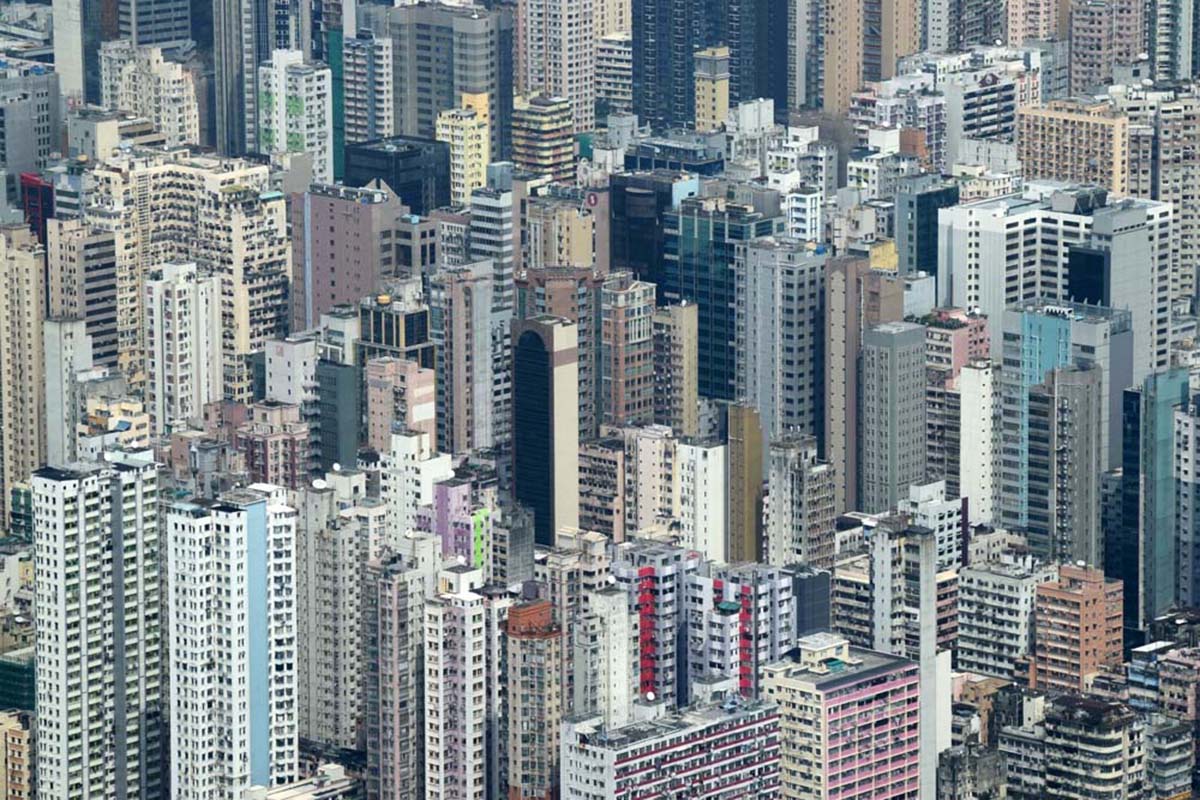
Delegates Reunited in Hong Kong for the Final Leg of the Conference. All delegates left early Thursday morning from their respective locations in Guangzhou and Shenzhen to travel by bus to Hong Kong, the final destination for the 2016 conference.
Unlike the trip from Shenzhen to Guangzhou, which was in the evening, the morning bus rode to Hong Kong and gave delegates the opportunity to experience the all-encompassing urbanization of the Pearl River Delta in the daytime as well as traversing the border crossing between Mainland China and Hong Kong (a Special Administrative Region). Upon arriving in Hong Kong, delegates were taken to the International Commerce Centre (ICC), the location of the Ritz Carlton Hong Kong and the conference venue for the city.

Eric Ma, Hong Kong’s Under Secretary for Development
Plenary 6 Focused on Hong Kong’s Unique Urban Development. Day Four of the conference began in earnest on the afternoon of October 20, with a plenary session entitled “Hong Kong Developments” held in the Sky100 observation space of the ICC.
Three in-depth presentations anchored the session, starting with Hong Kong’s Under Secretary for Development, Eric Ma, who detailed the history of skyscrapers in Hong Kong as well as the role that the local government plays in facilitating urban growth.
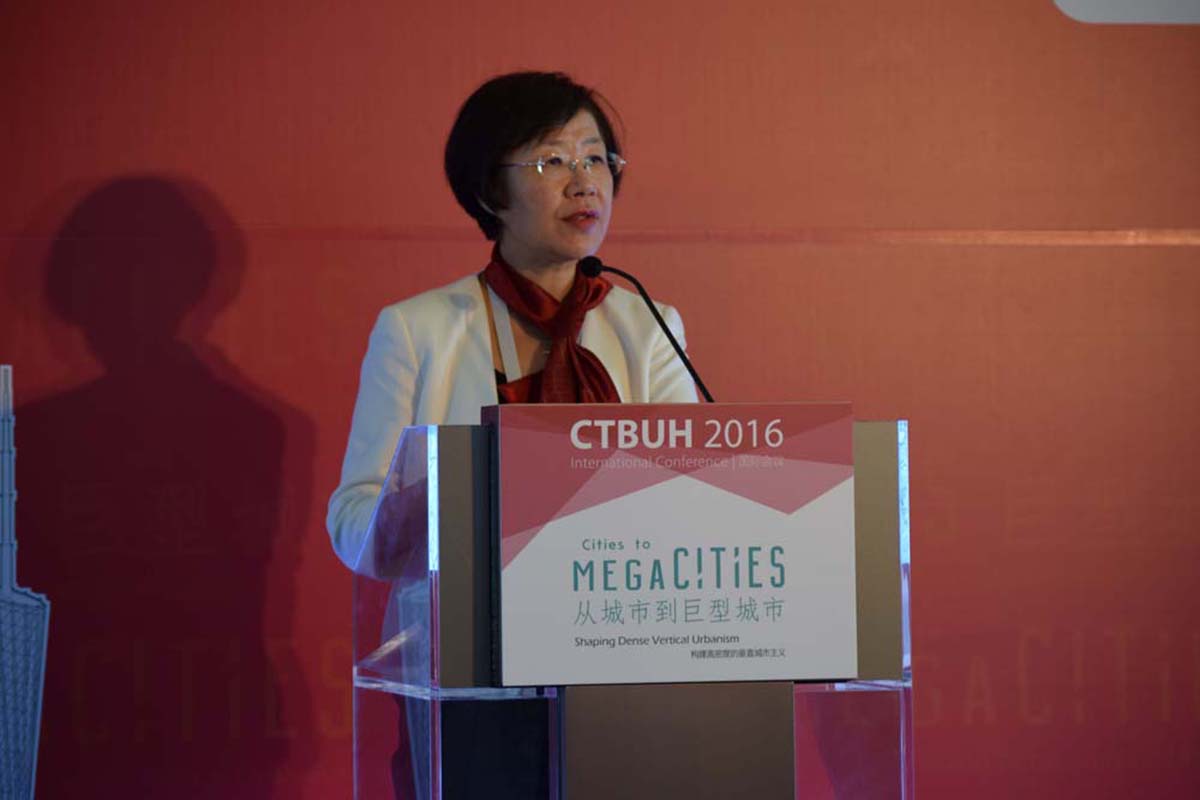
Ada Y.S. Fung, Hong Kong Housing Authority
Technical and Social Issues at the Forefront in Plenary 7. Ada Y.S. Fung, Deputy Director of the Hong Kong Housing Authority, presented on the history of public housing in Hong Kong as well as the design qualities that the authority promotes in their projects, such as acoustic balconies and windows to prevent noise pollution.
Fung’s presentation highlighted the significant role that public housing plays in shaping Hong Kong and providing residents with adequate housing at a reasonable price, while offering policies that can be replicated by authorities elsewhere.

Mike Wong, Sun Hung Kai Properties
ICC Networking Session Caps-Off Day Four Programming. That evening, attendees of the ICC networking reception, kindly hosted by Sun Hung Kai Properties and sponsored by Schindler, returned to the Sky100 Observation Space, which had been transformed from a forum for discussion into a swanky event space.
Warm welcomes were offered by Mike Wong, Deputy Managing Director, Sun Hung Kai Properties and Jujudhan Jena, President, Jardine Schindler Group, Schindler. Over refreshments and hors d’oeuvres, delegates took in the Hong Kong skyline while debating convivially the themes of the conference and discussing their own experiences throughout the week.
The Council on Tall Buildings and Urban Habitat was founded by Lynn S. Beedle in 1969 at Lehigh University in Bethlehem, Pennsylvania. The organisation has an extensive database on Tall Buildings' features, academic researches, CTBUH Journal, Tall Buildings' Height and Statistics, Competitions, Events, Conferences, Video Library and The Skyscraper Center Database featuring the World's 100 Tallest Buildings.
Top image: Guangzhou Skyline (CC-BY-SA), Joe Sau, all images courtesy of CTBUH 2016
> via CTBUH 2016
